parking brake JEEP RENEGADE 2015 1.G Owners Manual
[x] Cancel search | Manufacturer: JEEP, Model Year: 2015, Model line: RENEGADE, Model: JEEP RENEGADE 2015 1.GPages: 678, PDF Size: 29.84 MB
Page 46 of 678
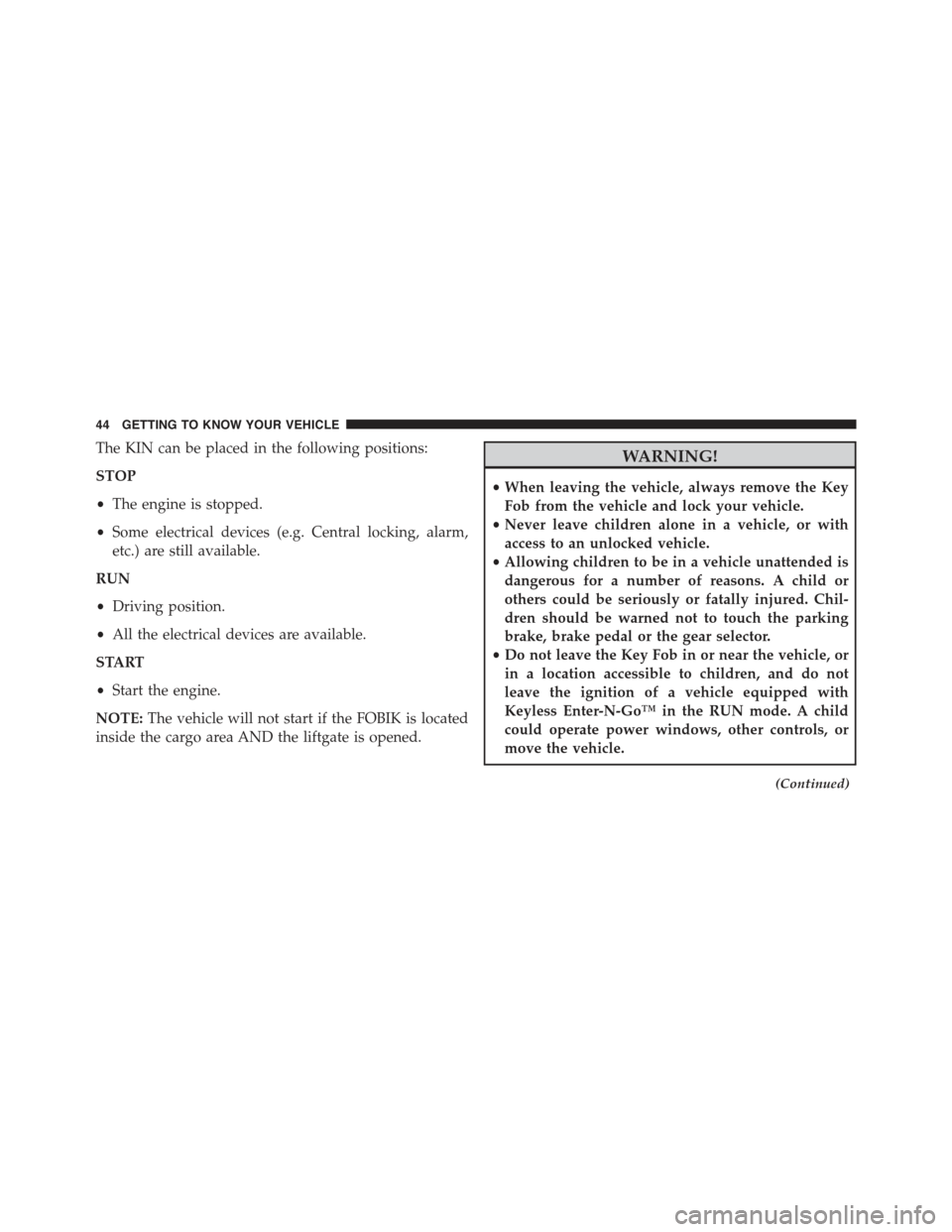
The KIN can be placed in the following positions:
STOP
•The engine is stopped.
•Some electrical devices (e.g. Central locking, alarm,
etc.) are still available.
RUN
•Driving position.
•All the electrical devices are available.
START
•Start the engine.
NOTE:The vehicle will not start if the FOBIK is located
inside the cargo area AND the liftgate is opened.
WARNING!
•When leaving the vehicle, always remove the Key
Fob from the vehicle and lock your vehicle.
•Never leave children alone in a vehicle, or with
access to an unlocked vehicle.
•Allowing children to be in a vehicle unattended is
dangerous for a number of reasons. A child or
others could be seriously or fatally injured. Chil-
dren should be warned not to touch the parking
brake, brake pedal or the gear selector.
•Do not leave the Key Fob in or near the vehicle, or
in a location accessible to children, and do not
leave the ignition of a vehicle equipped with
Keyless Enter-N-Go™ in the RUN mode. A child
could operate power windows, other controls, or
move the vehicle.
(Continued)
44 GETTING TO KNOW YOUR VEHICLE
Page 57 of 678
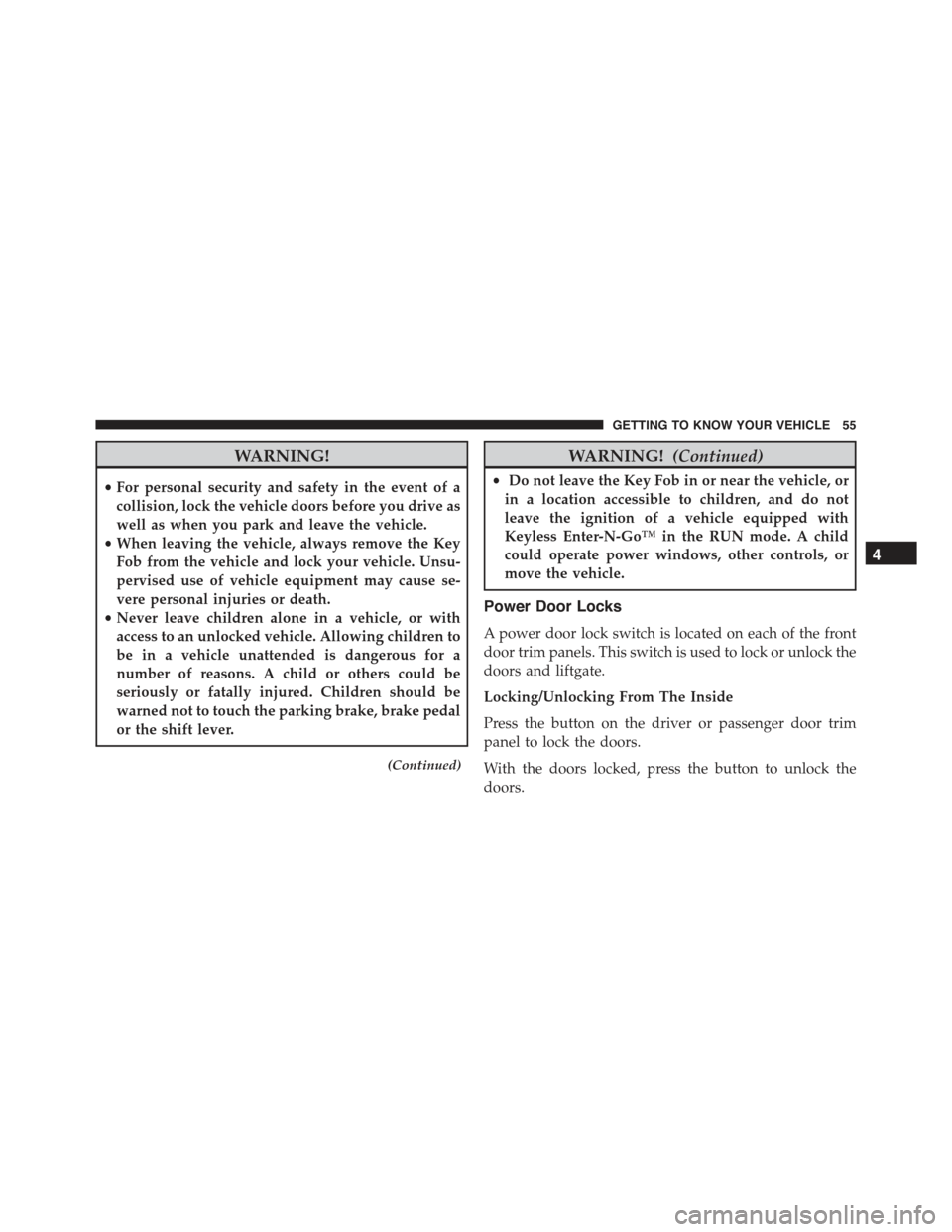
WARNING!
•For personal security and safety in the event of a
collision, lock the vehicle doors before you drive as
well as when you park and leave the vehicle.
•When leaving the vehicle, always remove the Key
Fob from the vehicle and lock your vehicle. Unsu-
pervised use of vehicle equipment may cause se-
vere personal injuries or death.
•Never leave children alone in a vehicle, or with
access to an unlocked vehicle. Allowing children to
be in a vehicle unattended is dangerous for a
number of reasons. A child or others could be
seriously or fatally injured. Children should be
warned not to touch the parking brake, brake pedal
or the shift lever.
(Continued)
WARNING!(Continued)
•Do not leave the Key Fob in or near the vehicle, or
in a location accessible to children, and do not
leave the ignition of a vehicle equipped with
Keyless Enter-N-Go™ in the RUN mode. A child
could operate power windows, other controls, or
move the vehicle.
Power Door Locks
A power door lock switch is located on each of the front
door trim panels. This switch is used to lock or unlock the
doors and liftgate.
Locking/Unlocking From The Inside
Press the button on the driver or passenger door trim
panel to lock the doors.
With the doors locked, press the button to unlock the
doors.
4
GETTING TO KNOW YOUR VEHICLE 55
Page 99 of 678

The timing of the headlights is adjustable between 0, 30,
60 and 90 seconds. Refer to “Uconnect® Settings” in
“Multimedia” for further information.
NOTE:The engine must be running before the head-
lights will come on in the automatic mode.
Daytime Running Lights (DRL) — If Equipped
The Daytime Running Lights (DRLs) will turn on when
the engine is started and remain on unless the headlights
are turned on, the electronic parking brake is applied, or
the engine is shut off.
The DRLs will be disabled during turn signal operation
and resume operation when the turn signal operation has
ended.
Front Fog Lights — If Equipped
The front fog light switch is built into the headlight
switch.
To activate the front fog lights, turn on the parking
lights or the low beam headlights and push the
headlight switch. To turn off the front fog lights, push the
headlight switch a second time or turn off the headlight
switch.
An indicator light in the instrument cluster illuminates
when the fog lights are turned on.
NOTE:The fog lights will operate with the low beam
headlights or parking lights on. Selecting the high beam
headlights will turn off the fog lights.
4
GETTING TO KNOW YOUR VEHICLE 97
Page 189 of 678

•What To Do
In the case of normal gear:stop the car, shut off the
engine, and check that the level of coolant inside the
tank is not below the minimum (MIN). In this case,
wait for the engine to cool, then slowly and carefully
open the cap, fill with coolant, make sure it is
between the MIN and MAX marks. Also, check for
coolant leaks. If at the next start-up, the light (or the
icon on the display) would once again illuminate,
contact an authorized dealer.
In the case of heavy use of the car (e.g. In terms of
performance):slow down and, if the light stays on,
stop the car. For two or three minutes, keep the
engine running and slightly accelerate to help the
flow of coolant in the system. Then, turn the engine
off. Check for the correct level of coolant as described
above.
Electric Park Brake Failure
•What Does It Mean
By placing the ignition in the MAR/RUN
position, the light (If Equipped) will illumi-
nate but should go out after a few seconds.
The light comes on when it detects a failure
in Electric Parking Brake.
The display shows the dedicated message.
•What To Do
Please contact your authorized dealer as soon as
possible.
NOTE:In this case, with heavy braking, the rear wheels
may lock early and increase the possibility of skidding.
5
GETTING TO KNOW YOUR INSTRUMENT PANEL 187
Page 218 of 678
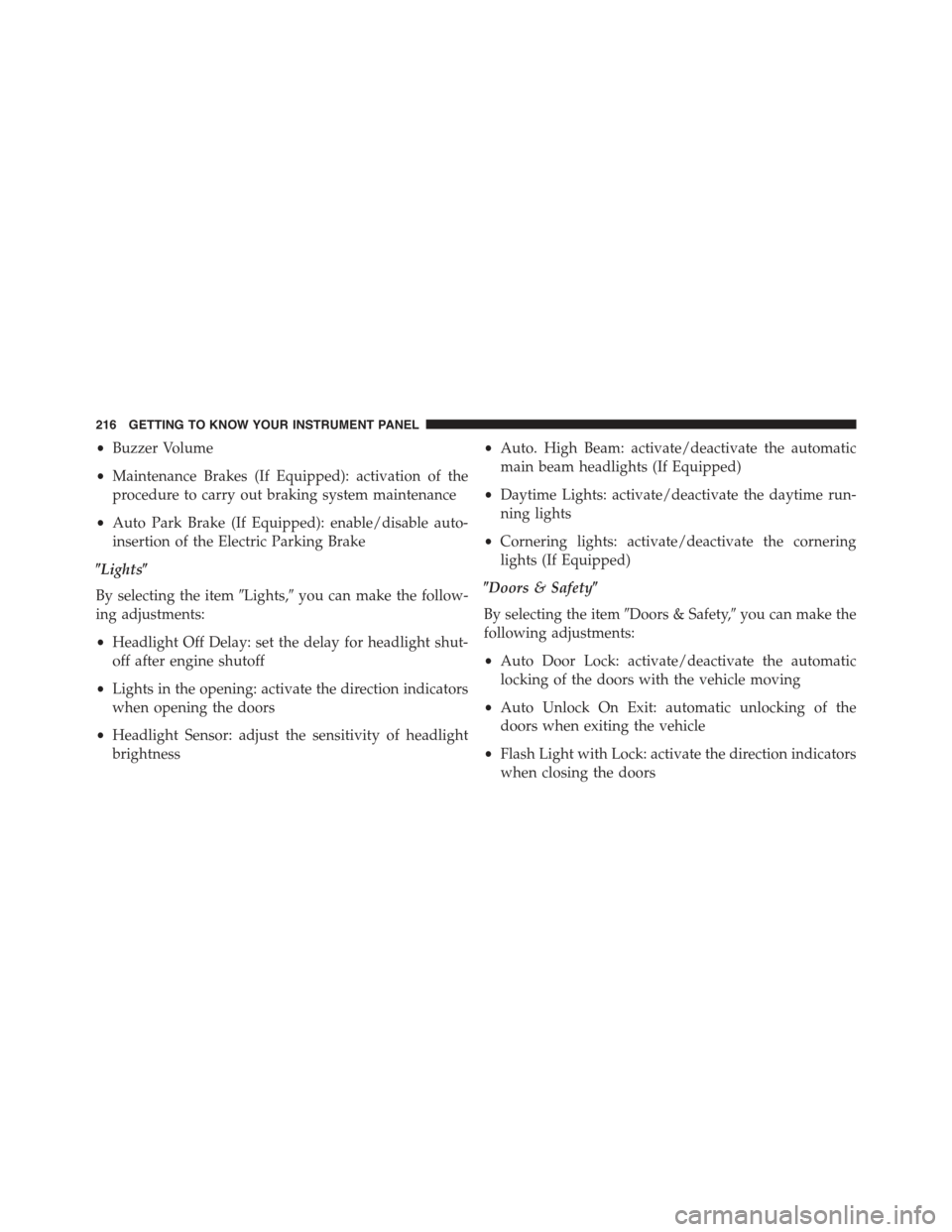
•Buzzer Volume
•Maintenance Brakes (If Equipped): activation of the
procedure to carry out braking system maintenance
•Auto Park Brake (If Equipped): enable/disable auto-
insertion of the Electric Parking Brake
$Lights$
By selecting the item#Lights,#you can make the follow-
ing adjustments:
•Headlight Off Delay: set the delay for headlight shut-
off after engine shutoff
•Lights in the opening: activate the direction indicators
when opening the doors
•Headlight Sensor: adjust the sensitivity of headlight
brightness
•Auto. High Beam: activate/deactivate the automatic
main beam headlights (If Equipped)
•Daytime Lights: activate/deactivate the daytime run-
ning lights
•Cornering lights: activate/deactivate the cornering
lights (If Equipped)
$Doors & Safety$
By selecting the item#Doors & Safety,#you can make the
following adjustments:
•Auto Door Lock: activate/deactivate the automatic
locking of the doors with the vehicle moving
•Auto Unlock On Exit: automatic unlocking of the
doors when exiting the vehicle
•Flash Light with Lock: activate the direction indicators
when closing the doors
216 GETTING TO KNOW YOUR INSTRUMENT PANEL
Page 229 of 678
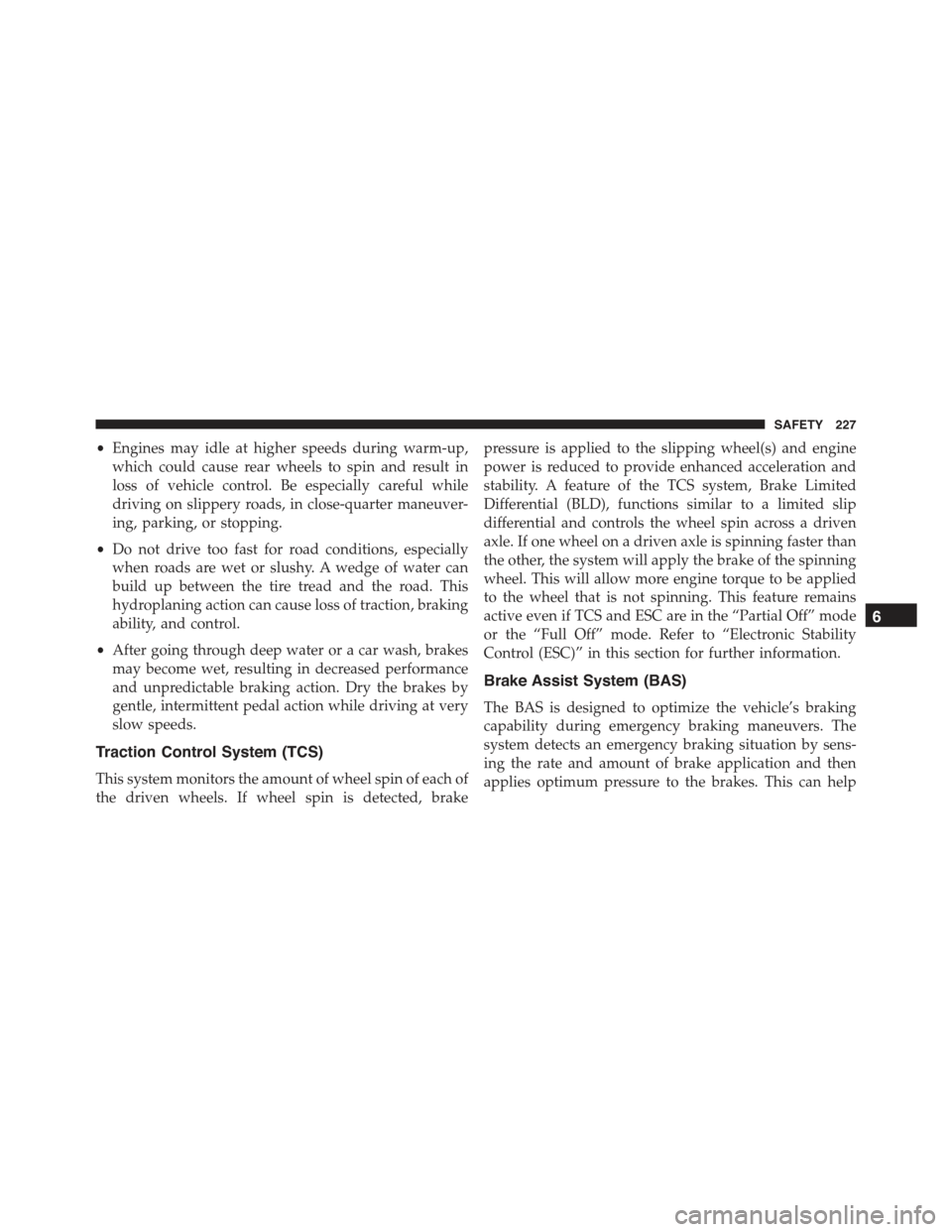
•Engines may idle at higher speeds during warm-up,
which could cause rear wheels to spin and result in
loss of vehicle control. Be especially careful while
driving on slippery roads, in close-quarter maneuver-
ing, parking, or stopping.
•Do not drive too fast for road conditions, especially
when roads are wet or slushy. A wedge of water can
build up between the tire tread and the road. This
hydroplaning action can cause loss of traction, braking
ability, and control.
•After going through deep water or a car wash, brakes
may become wet, resulting in decreased performance
and unpredictable braking action. Dry the brakes by
gentle, intermittent pedal action while driving at very
slow speeds.
Traction Control System (TCS)
This system monitors the amount of wheel spin of each of
the driven wheels. If wheel spin is detected, brake
pressure is applied to the slipping wheel(s) and engine
power is reduced to provide enhanced acceleration and
stability. A feature of the TCS system, Brake Limited
Differential (BLD), functions similar to a limited slip
differential and controls the wheel spin across a driven
axle. If one wheel on a driven axle is spinning faster than
the other, the system will apply the brake of the spinning
wheel. This will allow more engine torque to be applied
to the wheel that is not spinning. This feature remains
active even if TCS and ESC are in the “Partial Off” mode
or the “Full Off” mode. Refer to “Electronic Stability
Control (ESC)” in this section for further information.
Brake Assist System (BAS)
The BAS is designed to optimize the vehicle’s braking
capability during emergency braking maneuvers. The
system detects an emergency braking situation by sens-
ing the rate and amount of brake application and then
applies optimum pressure to the brakes. This can help
6
SAFETY 227
Page 243 of 678

on the steering wheel, to suggest the most correct ma-
neuver to the driver. The coordinated action of brakes
and steering increases the safety and car control feeling.
NOTE:The DST is a driving aid system and does not
replace the driver ’s actions while driving the car.
Selec Speed Control (SSC) — If Equipped
SSC is intended for off road driving in 4WD Low Range
only. SSC maintains vehicle speed by actively controlling
engine torque and brakes.
SSC has three states:
1. Off (feature is not enabled and will not activate)
2. Enabled (feature is enabled and ready but activation
conditions are not met, or driver is actively overriding
with brake or throttle application)
3. Active (feature is enabled and actively controlling
vehicle speed)
Enabling SSC
SSC is enabled by pressing the SSC switch, but the
following conditions must also be met to enable SSC:
•Driveline is in 4WD Low Range
•Vehicle speed is below 5 mph (8 km/h)
•Parking brake is released
•Driver door is closed
•Driver is not applying throttle
Activating SSC
Once SSC is enabled it will activate automatically once
the following conditions are met:
•Driver releases throttle
•Driver releases brake
6
SAFETY 241
Page 245 of 678

Driver Override:
The driver may override SSC activation with throttle or
brake application at any time.
Deactivating SSC
SSC will be deactivated but remain available if any of the
following conditions occur:
•Driver overrides SSC set speed with throttle or brake
application.
•Vehicle speed exceeds 20 mph (32 km/h) but remains
below 40 mph (64 km/h).
•Vehicle is shifted to park.
Disabling SSC
SSC will deactivate and be disabled if any of the follow-
ing conditions occur:
•The driver presses the SSC switch.
•The driveline is shifted out of 4WD Low Range.
•The parking brake is applied.
•Driver door opens.
•The vehicle is driven greater than 20 mph (32 km/h)
for greater than 70 seconds.
•The vehicle is driven greater than 40 mph (64 km/h)
(SSC exits immediately).
Feedback To The Driver:
The instrument cluster has an SSC icon and the SSC
switch has an LED which offer feedback to the driver
about the state SSC is in.
•The cluster icon and switch lamp will illuminate and
remain on solid when SSC is enabled or activated. This
is the normal operating condition for SSC.
6
SAFETY 243
Page 315 of 678

Periodic Safety Checks You Should Make Outside
The Vehicle
Tires
Examine tires for excessive tread wear and uneven wear
patterns. Check for stones, nails, glass, or other objects
lodged in the tread or sidewall. Inspect the tread for cuts
and cracks. Inspect sidewalls for cuts, cracks, and bulges.
Check the wheel nuts for tightness. Check the tires
(including spare) for proper cold inflation pressure.
Lights
Have someone observe the operation of brake lights and
exterior lights while you work the controls. Check turn
signal and high beam indicator lights on the instrument
panel.
Door Latches
Check for proper closing, latching, and locking.
Fluid Leaks
Check area under vehicle after overnight parking for fuel,
engine coolant, oil, or other fluid leaks. Also, if gasoline
fumes are detected, or if fuel or brake fluid leaks are
suspected, the cause should be located and corrected
immediately.6
SAFETY 313
Page 321 of 678
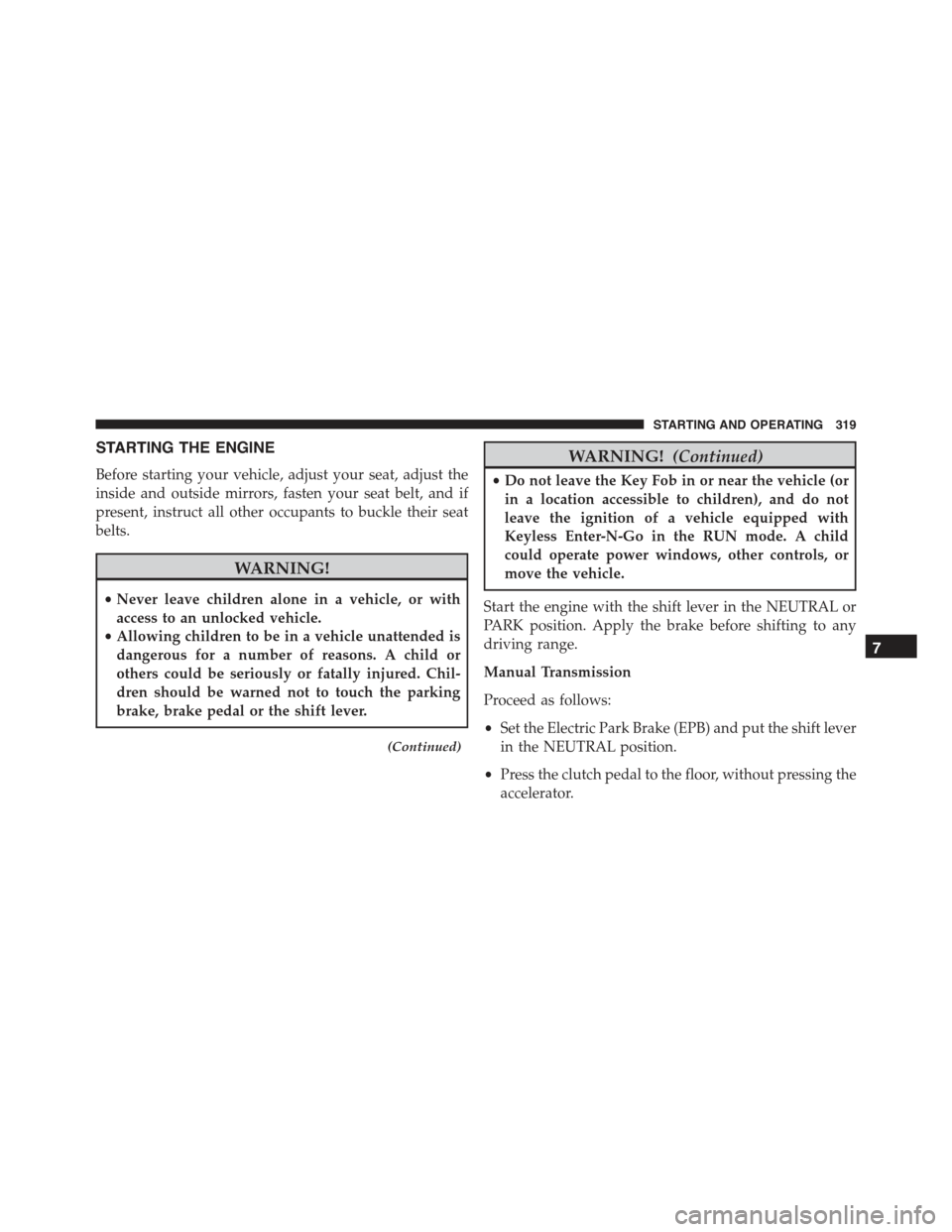
STARTING THE ENGINE
Before starting your vehicle, adjust your seat, adjust the
inside and outside mirrors, fasten your seat belt, and if
present, instruct all other occupants to buckle their seat
belts.
WARNING!
•Never leave children alone in a vehicle, or with
access to an unlocked vehicle.
•Allowing children to be in a vehicle unattended is
dangerous for a number of reasons. A child or
others could be seriously or fatally injured. Chil-
dren should be warned not to touch the parking
brake, brake pedal or the shift lever.
(Continued)
WARNING!(Continued)
•Do not leave the Key Fob in or near the vehicle (or
in a location accessible to children), and do not
leave the ignition of a vehicle equipped with
Keyless Enter-N-Go in the RUN mode. A child
could operate power windows, other controls, or
move the vehicle.
Start the engine with the shift lever in the NEUTRAL or
PARK position. Apply the brake before shifting to any
driving range.
Manual Transmission
Proceed as follows:
•Set the Electric Park Brake (EPB) and put the shift lever
in the NEUTRAL position.
•Press the clutch pedal to the floor, without pressing the
accelerator.
7
STARTING AND OPERATING 319